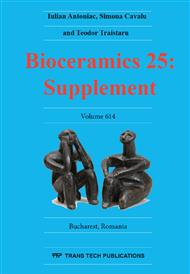[1]
J.B. Thompson, J.H. Kindt, B. Drake, H.G. Hansma, D.E. Morse, and P.K. Hansma, Bone indentation recovery time correlates with bond reforming time, Nature, 414 (2001) 773.
DOI: 10.1038/414773a
Google Scholar
[2]
F.H. Albee, H.F. Morrison, Studies in bone growth, triple calcium phosphate as a stimulus to osteogenesis. Ann. Surg. 71 (1920) 32.
DOI: 10.1097/00000658-192001000-00006
Google Scholar
[3]
M. Jarcho, Calcium phosphate ceramics as hard tissue prosthetics, Clin. Orthop., (1981) 259.
Google Scholar
[4]
R.G.T. Geesink, K. De Groot, Bonding of bone to apatite coated implants, J. Bone Joint Surg. Br., 70 (1988)17.
DOI: 10.1302/0301-620x.70b1.2828374
Google Scholar
[5]
H. Salmah, A.N. Azieyanti, Properties of recycled polyethylene/ chitosan composites: the effect of polyethylene-graft-maleic anhydride, Journal of Reinforced Plastics and Composites 30 (2011) 195-202.
DOI: 10.1177/0731684410391507
Google Scholar
[6]
A. Di Martino, M. Sittinger, M.V. Risbud, Chitosan: a versatile biopolymer for orthopaedic tissue-engineering. Biomaterials, 26 (2005) 5983-90.
DOI: 10.1016/j.biomaterials.2005.03.016
Google Scholar
[7]
M. Clochard, E. Dinand, S. Rankin, S. Simic, S. Brocchini, New strategies for polymer development in pharmaceutical science, J Pharm Pharmacol, 53(9) (2001) 1175-1184.
DOI: 10.1211/0022357011776612
Google Scholar
[8]
R. Muzzarelli, G. Biagini, A. Pugnaloni, O. Fillippini, V. Baldassarre, C. Castaldini, C. Rizzoli, Reconstruction of parodontal tissue with chitosan Biomaterials, 10 (1989) 598.
DOI: 10.1016/0142-9612(89)90113-0
Google Scholar
[9]
H. Matsuyama, M. Teramoto, R. Nakatani and T. Maki, Membrane formation via phase separation induced by penetration of nonsolvent from vapor phase. II. Membrane morphology, J Appl Polym Sci, 74 (1999) 171-178.
DOI: 10.1002/(sici)1097-4628(19991003)74:1<171::aid-app21>3.0.co;2-r
Google Scholar
[10]
L.C. Lin, S.J. Chang, S.M. Kuo, S.F. Chen, C.H. Kuo, Evaluation of chitosan/beta-tricalcium phosphate microspheres as a constituent to PMMA cement., J Mater Sci Mater Med., 16 (2005) 567-74.
DOI: 10.1007/s10856-005-0533-0
Google Scholar
[11]
C.O. Renó, B.F.A. S Lima, E. Sousa, C. A Bertran, M. Motisuke, Scaffolds of calcium phosphate cement containing chitosan and gelatin, Materials Research, 16 (2013) 1362-1365.
DOI: 10.1590/s1516-14392013005000124
Google Scholar
[12]
M. Sous, R. Bareille, F. Rouais, D. Clément, J. Amédée, B. Dupuy and C. Baquey. Cellular biocompatibility and resistance to compression of macroporous β-tricalcium phosphate ceramics. Biomaterials, 19 (1998) 2147-2153.
DOI: 10.1016/s0142-9612(98)00118-5
Google Scholar
[13]
A. Nirmala Grace and K. Pandian, Antibacterial efficacy of aminoglycosidic antibiotics protected gold nanoparticles—A brief study, Colloids and Surfaces A: Physicochem. Eng. Aspects., 297 (2007) 63–70.
DOI: 10.1016/j.colsurfa.2006.10.024
Google Scholar
[14]
T.Y. Chiang, C.C. Ho, D.C.H. Chen, M.H. Lai and S.J. Ding, Physicochemical properties and biocompatibility of chitosan oligosaccharide/gelatin/calcium phosphate hybrid cements. Materials Chemistry and Physics, 120 (2010) 282-288.
DOI: 10.1016/j.matchemphys.2009.11.007
Google Scholar
[15]
C.N. Cornell, D. Tyndall, S. Waller, J.M. Lane, B.D. Brause, Treatment of experimental osteomyelitis with antibiotic-impregnated bone graft, substitute, J Orthop Res, 11 (1993) 619–26.
DOI: 10.1002/jor.1100110502
Google Scholar
[16]
W. Jakubowski, A. lósarczyk, Z. Paszkiewicz, W. Szymaski, B. Walkowiak, Bacterial colonisation of bioceramic surfaces,. Adv Appl Ceram, 107 (2008) 217.
DOI: 10.1179/174367608x263395
Google Scholar
[17]
L. Wei, L.W. Zhaoyang, L.F. Xin-De, Chemical modification of biopolymers-mechanism of model graft copolymerization of chitosan, J. Biomater. Sci. Polym. Ed., 4 (1993) 557-566.
DOI: 10.1163/156856293x00780
Google Scholar
[18]
C.S. Cutter, B.J. Mehrara, Bone grafts and substitutes, J Long Term Eff Med Implants, 16 (2006) 249–60.
DOI: 10.1615/jlongtermeffmedimplants.v16.i3.50
Google Scholar
[19]
D. Tadic, M. Epple, A thorough physicochemical characterisation of 14 calcium phosphate-based bone substitution materials in comparison to natural bone, Biomaterials, 25 (2004) 987.
DOI: 10.1016/s0142-9612(03)00621-5
Google Scholar
[20]
M. Bohner, G.H. Van Lenthe, S. Grünenfelder, W. Hirsiger, R. Evison, R. Müller, Synthesis and characterization of porous beta-tricalcium phosphate blocks, Biomaterials, 26 (2005) 6099.
DOI: 10.1016/j.biomaterials.2005.03.026
Google Scholar
[21]
M. Bashoor-Zadeh, G. Baroud, M. Bohner, Geometric analysis of porous bone substitutes using micro-computed tomography and fuzzy distance transform, Acta Biomaterials, 6 (2010) 864–75.
DOI: 10.1016/j.actbio.2009.08.007
Google Scholar
[22]
K.S. Chen and R.F. Hsu Evaluation of environmental effects on mechanical properties and characterization of creep behavior of PMMA, Journal of the Chinese Institute of Engineers, 30 (2007) 267-274.
DOI: 10.1080/02533839.2007.9671253
Google Scholar
[23]
K.S. Bong, K.Y. Jick, Y. T. Su A. P. Limnd, The Characteristics of a Hydroxyapatite-Chitosan-PMMA Bone Cement, " Biomaterials, 25 (2004) 5715-5723.
Google Scholar
[24]
R.K. Roeder, M.M. Sproul and C.H. Turner, Hydroxyapatite Whiskers Provide Improved Mechanical Properties in Reinforced Polymer Composites, Journal of Biomedical Materials Research Part A, 67A (2003) 801-812.
DOI: 10.1002/jbm.a.10140
Google Scholar
[25]
P.N. Manson, W.A. Crawley, J.E. Hoopes, Frontal cranioplasty: risk factors and choice of cranial vault reconstruction material. Plast Reconstr Surg. 77 (1986) 888.
DOI: 10.1097/00006534-198606000-00003
Google Scholar


